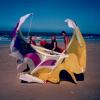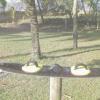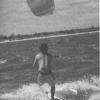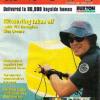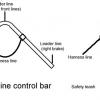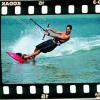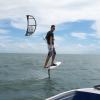Mat and Beck Colefax. Australia's 1st kiteboarders.
When Mat started the sport off in Australia he had a choice of buying and importing a kiteski (mini hanglider with reelbar) or Concept Air (mini paraglider mattress style) or Wipika (the 1st inflatable kite) Mats choice of Wipika has proven right and stood the test of time. Kiteboarding 'happened' because of the Wipika inflatable revolution!
As the only kiteboarder in Australia at the time and one of the 1st in the world, with no example to follow Mat tried a whole range of boards and skis. From a 5' wakesurfer from his waterskiing right up to windsurfer one design boards bigger and heavier than todays standup paddleboards. In the very begginning he settled on his 7' bushman thruster surfboard. Which now all these years later is back in vogue with recent kitesurfboard 'gun' shapes looking surprisingly similar ! This board of course takes pride of place in 'Mats museum'. Alongside a collection of boards from those early days.
In 2000 Mat and Beck not only succeeded in getting an advertising gig with their kites, no less than Coca Cola came to the party with their Waves of Freedom Campaign. Primetime TV, cinema, billboards, buses, POS, prize giveaways, a series of events and more. Nothing before or since has ever come close to that magnitude. It was the decided turning point for kitesurfing. Wipika 2 line kites were of course the centerpiece creating this spectacle. *note coca cola have no current connection or sponsorship of this site*
The very first production run of inflatable kites for surfing was Wipika 5.0 classic kites at the Pryde factory in mid 1997. Those first kites were made from mylar and polyester ripstop, with a basic 2 line bridle. They were marked simply with "Wipika" in black text some are pictured here at top left. in fact Mat and Beck both still have their kites from that 1st production run although only Becks is still in working order. Mat does keep a brand new unmarked 1st production Wipika and original control bar as an investment and souvenier. "the teak boom of kitesurf"
Within a year the production was shifted to China, with an 8m and then 6.5 scaled models, which in spite of being pigs to fly enabled us to kite in light winds so really opening the sport up. The Wipika sizing was calculated at about 2/3 of the flat area of the kite. So the 8m was about the size of modern 11. It was not long before several copies like the Naish came on market, and of course now inflatable is the norm for all water kiting, although sadly Wipika the 1st kiteco. is long dormant.
The 1st bars had a shackle quick release and leash on one line which was supposed to offer a level of safety. Typically they were almost a full meter in length to enable some response in the kite. We thought we did well if we got things to work with a sub 80cm bar ! It very quickly became apparent that mechanical releases (steel or plastic) could be unsafe because they jam due to bending, sand and corrosion. Make sure if you have a mechanical release that it gets checked and maintained properly.
A good example of non mechanical no maintanence safety is some retro F-one velcro QR's, a company that has been around since the beggining. In fact the first production kiteboards ever were made by F-one, they did not build kites for the 1st few years. Their 230 and 215cm epoxy thruster directionals had 3 footstraps layed out like a windsurfer, and were meant to be tacked and gybed in similar fashion. One used for the Coca Cola kite campaign survives in the 1st kiteboarders extensive memorabilia collection. And that along with a big swallow tail Stonker directional can be glimpsed in the Coca Cola video above.
Early in the piece Aussie Alex Gillan of Stonker kiteboards supplied Mat and Beck with several custom directionals which also survive in the collection amongst many other historic boards. The Hawaians however were already riding wakeboards. Seeing that Mat commissioned what could be the 1st twintip in the world from Alex, it had six fins (thrusters each end) and centered wakestyle stance and was likely around 155cm long, it is pictured at left top on a post. Shortly after that we were riding the LF trip wakeboards a lot. They were over 42cm wide and had 1" thruster fins each end.
Around that time Mat got editor of wakeboarder magazine Brendan Wulf to run an article about kiteboarding, the 1st Australian magazine article on kiting. Mat also ended up sponsoring the pro windsurfer Wes Greene who got the 1st cover shot. Both Wes (smiling) and Brendan (unhooked) pictured at left. Wes later worked as a TV presenter and did a show on Mat and friends hitting railslides with kites, the 1st time kiters rode rails in Australia. The railslides were borrowed from Dimitrius Limnatis of Boarder magazine, who Mat later lobbied to start an Aussie Kiteboard magazine. That Magazine exists today as Kiteboarder Mag with Mat being the perpetual 1st "kiteco" advertiser, 1st page inside front cover for the duration.
During those early years Mat and Beck made many trips around Australia and the world, and were the first to ride most of the coast. It would be no surprise to find out they have kited your local however remote and obscure ! Some of the more memorable spots have become world famous kite magnets, and some have remained semi secret. A long time ago in a galaxy far away they even used to hit up the snow all over the high plains. Below is a video courtesy Snowshow www.snowshow.tv
Some places are only now being discovered because of the limitations of early gear. For example hydrofoil kiteboarding has opened up a whole new raft of spots that previously were too gusty. And the new Delta C-shape kites mean what was unrideable before is now unreal. The funny thing is that this latest development of kite shape looks more like the original 2 lines than anything else ! the obvious difference being 4 instead of 2 lines. Check out the F-one Bandit kite in the video below for its retro shape. Rider Mat Colefax, the 1st to explore every aspect and genre of inflatable kiteboarding in Australia including bindings, unstrapped, wakesk8ing, railpark, kitefreedive, supkite, journey overnighting, you name it, hes done it 1st just like the hydrofoiling below.
Although 4 lines was the original design for the hi performance prototype Wipika inflatable kites in the 1980's it was not until around 2000 that the market was ready to release 4 lines to the masses. Before that Mat had made a 4 line bar as pictured at left, which allowed sheeting control while unhooked, and he used it with both Wipika kites and other types. It was not the only invention Mat tried and we will add to this post with more fascinating facts later.
Names and places of 1st shops to buy our Wipika inflatable kites: Cameron and Lloyd of 4winds in Geelong, Dale of kiteshop in Rye, Lachlan of skytes in Southport, Andrius in Sydney (now bboard narrabeen), Chris De-Aboitz of Kitesurf in Noosa (yes its Keahis dad), Dave and Alex in Melbourne, Ian in Perth, and Roy and Bruce in Cairns.
